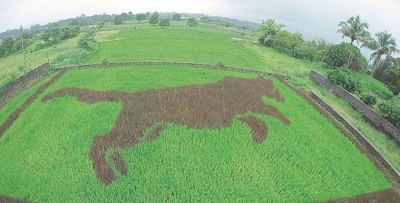
India’s first paddy artist, Shrikant Ingalhalikar, has ‘painted’ a 120 x 70 foot Bamboo Pit Viper on his rice field at Gorhe Budruk on Sinhagad Road near Pune. Started by the farmers of village Inakadate in Japan in 1993, Tambo Ato or ‘paddy art’ involves planting rice of various types and colours to create images in a paddy field. This is the fourth year that Shrikant has created an eye-catching shape in his rice field by planting seedlings of coloured rice in a systematic pattern. He created paddy art of Lord Ganesh in 2016, a black panther in 2017 and an emerald dove in 2018. An engineer and amateur botanist, Shrikant minutely plans the artwork first on paper and then on the computer. He wants to keep the art form alive and at the same time encourage youngsters in nearby villages to take up agriculture.
The paddy sowing started in August with two different paddy varieties, one green and the other purple. Ingalhalikar has been growing rice on his field for the past 25 years and has been collecting and conserving different varieties of rice for over five years.
With just two different colours, he and his team entered the field knee-deep to sow the crops, “It was really challenging for us. We started in August but it didn’t rain for a very long time but thankfully, the rain has picked up since the past few days.”
Located near Donje Phata on Sinhagad Road, the rice field on which the black panther has been designed looks ideal from a bird’s eye view. “We just opened. I was waiting for Ganeshotsav to get over. Now, the colours will mature and you can see it. Black panthers are not generally black, they are darker shades of purple. The purple rice variety matches this shade. The harvest will be in December and people can come and view the field till then.”
Ingalhalikar is also a nature lover who has studied rare species of trees in Pune for a few years and will soon release a book t them. “Pune has 500 rare species of trees but in the past years, ten of these species have gone missing,” he claims.
Credit : Pune365
Picture Credit : Google




